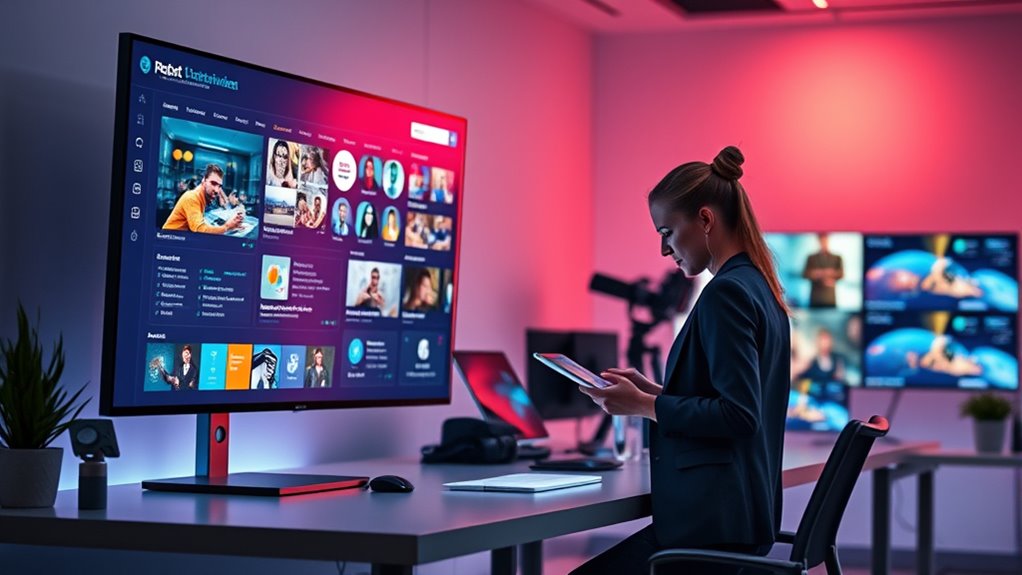Leveraging a headless CMS lets you easily scale your content across multiple channels like websites, apps, and IoT devices. Its API-first approach separates your content from presentation, giving you flexibility to deliver a consistent experience everywhere. This setup handles increased traffic smoothly and simplifies adding new platforms without major overhauls. With a decoupled architecture, you gain faster development and better customization, positioning your content for future growth and omnichannel success—exploring further reveals even more advantages.
Key Takeaways
- Headless CMS separates content from presentation, enabling seamless multi-channel delivery across websites, mobile apps, and IoT devices.
- It enhances scalability by supporting increased content volume and user traffic without infrastructure overhaul.
- The decoupled architecture allows quick deployment of new channels or devices, ensuring consistency and speed.
- Flexible APIs facilitate tailored content delivery, improving omnichannel user experiences and engagement.
- Headless CMS streamlines workflows and developer agility, accelerating innovation and supporting rapid digital expansion.

In today’s fast-paced digital landscape, leveraging a headless CMS can substantially boost your content management capabilities. Unlike traditional systems, a headless CMS separates the content repository from the front-end presentation layer, giving you incredible API flexibility. This means you can deliver your content seamlessly across multiple channels—websites, mobile apps, IoT devices, and even emerging platforms—without being confined to a single framework or interface. The flexibility of APIs allows you to customize how content is retrieved and displayed, empowering you to craft tailored user experiences with ease. It also simplifies integrations with other tools and services, making your workflow more agile and adaptable to changing needs. Additionally, utilizing a headless CMS can improve content scalability****, enabling your infrastructure to handle increased content volume and user demands more efficiently.
When you choose a headless CMS, you’re also enhancing the developer experience. Developers appreciate the freedom to work with their preferred programming languages and frameworks, rather than being restricted by rigid, monolithic architectures. This flexibility reduces development time and enables quicker iterations, so you can launch updates faster and respond promptly to user feedback or market shifts. The API-driven nature of a headless CMS means your development team can build, test, and deploy content delivery mechanisms independently from the content editing interface. This separation streamlines workflows, reduces bottlenecks, and fosters a more collaborative environment where developers and content creators can operate more efficiently.
Moreover, the decoupled architecture of a headless CMS provides scalability that’s essential for growing digital demands. Since your content isn’t tied to a specific front-end, expanding your reach to new platforms or devices becomes straightforward. You can develop and deploy new channels without overhauling your core content infrastructure. This scalability ensures your content delivery remains swift and reliable, regardless of traffic spikes or increased content volume. The API-centric approach also means you can implement caching strategies and load balancing to optimize performance, ensuring your users experience fast, consistent access no matter where they are.
Ultimately, leveraging a headless CMS transforms your content management into a flexible, scalable system that adapts to your evolving needs. It enhances developer experience by providing freedom and efficiency, while API flexibility enables you to deliver rich, consistent content across all channels. This combination equips you with the tools to stay competitive in a digital world that demands speed, customization, and omnichannel presence. By embracing a headless approach, you position yourself to innovate rapidly, scale effortlessly, and meet your audience wherever they are, with compelling, personalized content.
Frequently Asked Questions
How Does Headless CMS Impact Website Performance?
A headless CMS improves your website performance by enabling faster load times and smoother experiences. Its API flexibility allows you to deliver content efficiently across devices, reducing delays. You can also customize content more easily to meet user needs, which enhances engagement. Because it separates content management from presentation, your site stays agile, scalable, and responsive, ensuring peak performance even as your content and audience grow.
Is a Headless CMS Suitable for Small Businesses?
You can definitely consider a headless CMS for your small business, as it’s a game-changer. While it offers flexible content customization and enhances user experience, it’s not a one-size-fits-all solution. Think of it as a double-edged sword—costs and technical skills required might be higher than traditional options. If you’re ready to invest in growth and have the resources, it can help your business scale smoothly and reach audiences everywhere.
What Are the Security Concerns With Headless CMS?
You should be aware that headless CMS security concerns include data breaches, which can expose sensitive content and user data. To protect yourself, guarantee robust user authentication measures are in place, like multi-factor authentication and strong access controls. Regularly update your CMS and plugins, monitor for vulnerabilities, and encrypt data during transmission. Staying vigilant helps you mitigate risks and keep your content and users safe.
How Does Headless CMS Integrate With Existing Systems?
Think of your systems as a well-orchestrated symphony, seamlessly harmonized through API integration. You can connect your existing platforms—like e-commerce, CRM, or analytics—by leveraging APIs, enabling smooth data synchronization. This integration allows your headless CMS to act as the maestro, coordinating content delivery across channels while ensuring your data stays consistent and up-to-date with minimal disruption.
What Are the Costs Involved in Implementing a Headless CMS?
You’ll need to consider costs for content migration, which can be time-consuming and may require extra resources. Vendor selection impacts your budget, as different providers charge varying fees for licensing, support, and customization. Additionally, account for ongoing expenses like hosting, maintenance, and updates. Planning ahead helps you estimate total costs more accurately, ensuring you choose a headless CMS that fits your budget while meeting your scalability and omnichannel delivery needs.
Conclusion
By harnessing a headless CMS, you’re building a digital highway that seamlessly delivers content across every platform. It’s like planting a versatile seed that grows into a mighty tree, providing shade and fruit across all channels. With scalability and flexibility at your fingertips, you can adapt and thrive in a rapidly evolving landscape. Embrace headless CMS, and watch your content flow effortlessly—turning your vision into a vibrant, interconnected ecosystem.








